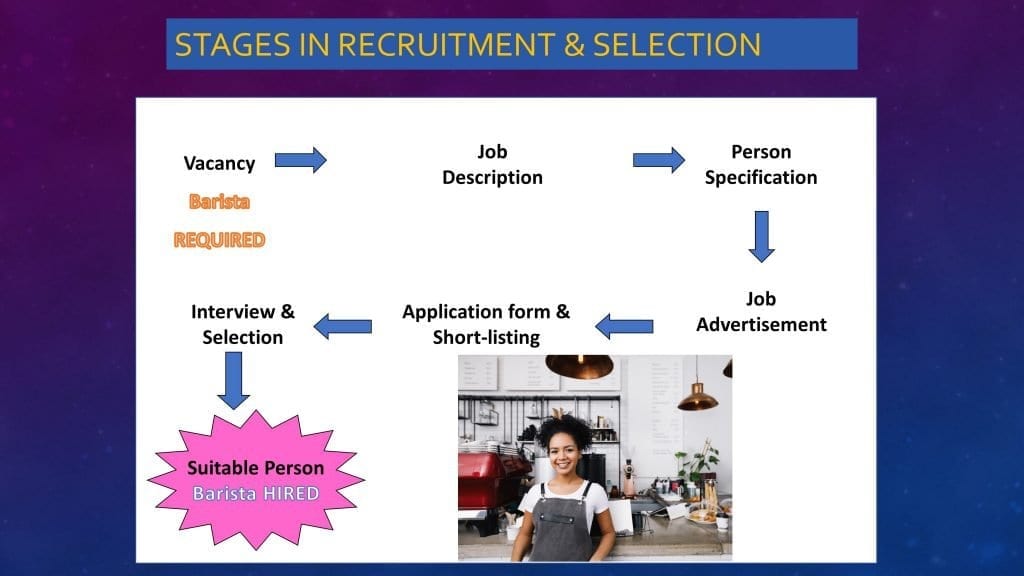2.3.1 Recruitment and Selecting Employees
Success or failure may depend on getting the right people to join a business team. If the business hits hard times, survival may depend on reducing the size of the workforce, and keeping the right employees to push the business back into profitability.
Furthermore, training plays a crucial role in not only increasing the efficiency and effectiveness of staff, but also in motivation and retention (reducing labour turnover).
Internal Recruitment and External Recruitment
Internal recruitment is finding someone for the vacancy that already works for the business. As the old saying goes: “better the devil you know than the devil you don’t”.
It’s beneficial because the employee is a known quantity. managers will know their performance, their strengths and weaknesses and feel confident they are a good fit for the business.
Furthermore, it will limit induction and training costs as the employee knows how the business operates already.
Finally, it acts as an incentive to other employees, if workers see hard work and initiative results in promotion to a higher position in the business, they will work harder. Internal recruitment may fill the empty position, but the business still needs to find a replacement for the post that the employee has just been promoted from.
External Recruitment allows a much wider choice of potential applicants, and can bring new ideas, fresh thinking and better ways of doing things.
Although there is a higher recruitment cost, there may not be enough suitably skilled employees to fill the vacancies with internal recruitment, so often businesses must recruit externally.
Main stages in recruitment and selection of employees

Let’s use the example of Mariam who needs to hire a new barista at her coffee shop Lokal Kopi Co. and go through each stage of the recruitment process with her
The first step is identify all the roles and responsibilities that will be included in the position. This is called the job description. Here we see an example for Lokal Kopi.

The next step is to think of the skills that are required to fulfil the tasks in the job description. This is called the person specification. This the skills and experience Mariam is looking for in a new barista.

There is a close relationship between the two but remember job description is related to the roles and responsibilities, person specification to the skills and experience
Next we have to try and connect with the best possible candidates for the position and let them know about the job, normally done through a job advertisement. Mariam wants to hire locally so will advertise in a local newspaper or a local jobs website. The job advertisement will tell potential applicants about the job, what the requirements are and encourage them to apply.
For more specialist skills businesses might go to a specialist websites For example, the Times Educational Supplement is the main source of international teaching jobs.
Once Mariam has received all the applications she won’t have time to interview all of the candidates. However, she will want to be able to meet the best applicants, test their skills and find out if they are good “fit” for the business.
So she will shortlist the the best 3 or 4 candidates who have the most suitable skills and experience in their applications. Traditionally, the next step is an interview, where employers ask potential employees questions to decide if they are suitable for the job. But it also makes sense to test the applicants skills. So Mariam might check if the barista can make different kinds of coffee, or try a sample dish from a chef. This ensures that the business can assess which applicant has the best skills and doesn’t just make a good impression from an interview.
The final step for Mariam is to select the best candidate for the job, based on all the information about each candidate.
Recruitment and selection takes time and is an investment. Although it’s important for the process to be cost effective, finding someone who is unsuitable will result in much higher costs for a business. For Mariam, if the new barista results in an unsatisfactory experience for customers it could result in a loss of sales. However, finding a barista that will be an asset to the business will make the business much more successful.
Recommend and justify who to select
Deciding who is best will depend on the needs of the business, that’s why this question (when it comes up) is usually in Paper 2 where there is more information available on which to base an answer.
| Past Paper Question Example Paper 2 (b) Consider the advantages and disadvantages of the following candidates Mariam could select for the vacant Barista position. Recommend which candidate Mariam should choose. [12] * Kim * Kanye * Donald * Recommendation |
There is no right or wrong answer here, the key is to keep your answer in context and explain why the candidate you recommended for selection is:
1) More suitable than the other two
2) Will lead to the long-term success of the business.
Benefits and limitations of full time and part time employees

Part time workers allow a business more flexibility, part time employees can work more hours during busy periods of the year and less hours when there is less demand.
Part time workers are often more productive, this may be because they are less tired or more motivated than full time staff.
Part time working can allow employees to have greater work life balance. For example, parents might cut down to working three days a week so they can look after their children.
However, part time staff can be an additional cost in training and recruitment. If two part time staff are hired to work 20 hours a week in the place of one staff member who can do 40 hours a week this may mean double the recruitment costs.
Full time employees may be more committed to the company and more likely to aim for promotion.
Part time employees may make communication more difficult. There will be more staff members who are at work less, so it is harder for messages to be delivered clearly. This may also have a negative impact on service as a customer has to deal with a number of different part time employees rather than one full time employee.
It can be highly beneficial for a business to employ a mix of full time and part time employees. It allows the business to benefit from the greater flexibility part time staff can offer with the commitment and continuity that full time staff offer.
Giving the option of part time work can allow businesses to hire the most effective employees and keep them motivated as they can balance work and commitments outside of work.
However, this will depend on the industry. Professional, highly skilled jobs are more likely to be full time and less skilled temporary jobs are more likely to be part time.
2.3.2 The Importance of Training and the Methods of Training
It’s one thing to hire the most effective staff, but it’s only the first step in making employees as productive as possible and contributing to a successful business.
Training ensures that when employees start a new job they are not just “thrown in at the deep end”. If new employees feel supported with all the skills and information they need when starting a new job they will be more productive sooner, have a higher quality output, and be much more highly motivated. Employees will also be much more likely to stay with the business.
Induction Training aims to quickly make employees feel comfortable in their new workplace by setting out the basics of what they need to know about working at the organisation. A lot of it can be “boring but important” details like where the bathroom or coffee machine is, and safety procedures like the fire drill. It’s also important for employees to learn about the business: what it does, what its aims are and what it expects of employees.
Induction training is an additional cost, however, it’s often essential, particularly in larger organisations, to settle employees quickly and ensure long term motivation and productivity. If employees’ first experience of the business is unsatisfactory, it can take a long time to repair the damage.
On the job training is when a new staff member learns new skills in the workplace from an experienced employee. For example, watching how to assemble parts on a factory production line and then completing the tasks under supervision.
On the job is lower cost than off the job training, and employees can find out exactly how the job is done in their workplace.
However, they may pick up bad habits from the experienced employee, and it may result in reduced output as new employees will take time to get up to speed.

Off the job training is much more expensive than on the job as it takes place away from the workplace, usually at a specialist training facility like a university or college. It is used when employees have to learn a highly specialist skill, like how to operate a new kind of computer system or a specialist management skill.
Although it may be a greater cost, it may be the only way of allowing employees to learn the latest specialist technical skills which may be essential for the effective and efficient operation of the business.
Training is expensive, and requires additional organisation and leadership. However, the short term costs of investing in training often results in long term benefits for the business because of higher productivity and high quality output.
The choice of on the job or off the job often depends on the type of position. The more technical and skilled the job, the more likely it will be off the job training.
2.3.3 Redundancy and Dismissal
It may be one of the hardest parts of any manager or leader’s role, but just as businesses must recruit new employees, they also have to reduce the size of the workforce.
Ultimately, leaders are responsible for the long term profitability and competitiveness of the business. No business can afford to keep employees that aren’t productive and must consider all opportunities to reduce costs.
There are four ways in which employees can stop working for an organisation: resignation, retirement, redundancy and dismissal. Redundancy and dismissal are the ones the Cambridge syllabus focus on.
Resignation is when an employee leaves a job due to their own free choice, usually to move on to another job, or a change in personal circumstances.
Retirement – in some countries employees must stop working at a certain age.
Redundancy or “letting go” of an employee occurs when the job position no longer exists, and the employee can’t be moved to another vacant position. This can happen when a part of a business closes down or a factory relocates to another country where the cost of production is cheaper.
Dismissal it the “your fired” moment. For either an employee breaking company rules, or for incompetence, not being able do the job to the required standard.
Why reducing the size of the workforce might be necessary
Reducing the size of the workforce (or downsizing) is required for three main reasons.
Firstly, if there is lower demand for a particular product then it may not be profitable to continue production, so employees have to be let go.
Secondly workers may have to be made redundant if more efficient machinery or artificial intelligence can take over their role, or if a business relocates to another country or area where costs are lower.
Recommend and justify which employees to make redundant in given circumstances
This is essentially a recruitment and selection question in reverse. Instead of choosing the best person to employ you are choosing which employees to keep and which employee to let go. For example, if demand falls for a product a business may have to make two members of a 10 employee team redundant. However, this is a much less popular question than selection however.
With redundancy you must ensure the system is fair. This will minimise the negative impact on employee motivation, if workers know why some of their co-workers were made redundant, and why it was unavoidable.
Often businesses ask for voluntary redundancy first. So they aren’t forced to choose which employees to let go. They can use a “Last in First Out System” so the last person to be employed is the first person to be made redundant if the business has to downsize.
2.3.4 Legal Controls over Employment Issues and their Impact on Employers and Employees
Although there is no mention of it in the specification, large businesses employ human resources professionals to ensure they don’t break any laws.
In order to protect employees from unfairness and discrimination at work many countries pass laws to ensure organisations treat workers fairly.
Employees or governments may take legal action against businesses who break these laws. Legal action is when a business is taken to court. This is usually a very high cost for a business, damages a businesses reputation and has a negative effect on employee motivation.
As Cambridge is an international qualification, and each country has different laws regarding employment, what you need to know for legal controls is very broad, but there are four “need to know” legal controls on employment.
Unfair dismissal is when an employee has their employment terminated unfairly. For example, if an employee is dismissed, because they support a different football team from the boss of the company.
For an employee it means they have protection against unfair dismissal and may sue the business if they feel they have been unfairly dismissed.
For businesses it means they have to be very careful when dismissing staff to make sure they have followed all the proper procedures, to make sure no legal action is taken against the business.
Discrimination is being treated differently on the basis of sex, age, gender, ethnicity or sexual orientation.
Discrimination can occur during recruitment of new employees or anywhere where managers make decisions about employees’ working life, like promotion or deciding which tasks different employees do.
If employees are discriminated against they can take legal action so businesses need to have rules and procedures in place to make sure all employee are treated fairly, and if there is an accusation of discrimination it can investigated thoroughly.
Health and Safety is the duty of businesses to ensure all employees are safe at work. This means employees are properly trained, given the correct PPE (personal protective equipment) and making sure all machinery is safe.
Employees have a duty to follow health and safety rules and report any danger in the workplace.
Again, there can be legal action if Health and Safety rules are not followed. If an employee is injured at work they may take legal action against the business. Legal Minimum Wage – in many countries there is a minimum amount employees must be paid per hour or per month. If a minimum wage is introduced or increased, businesses will need to review their costs to ensure they can continue to operate profitably.

